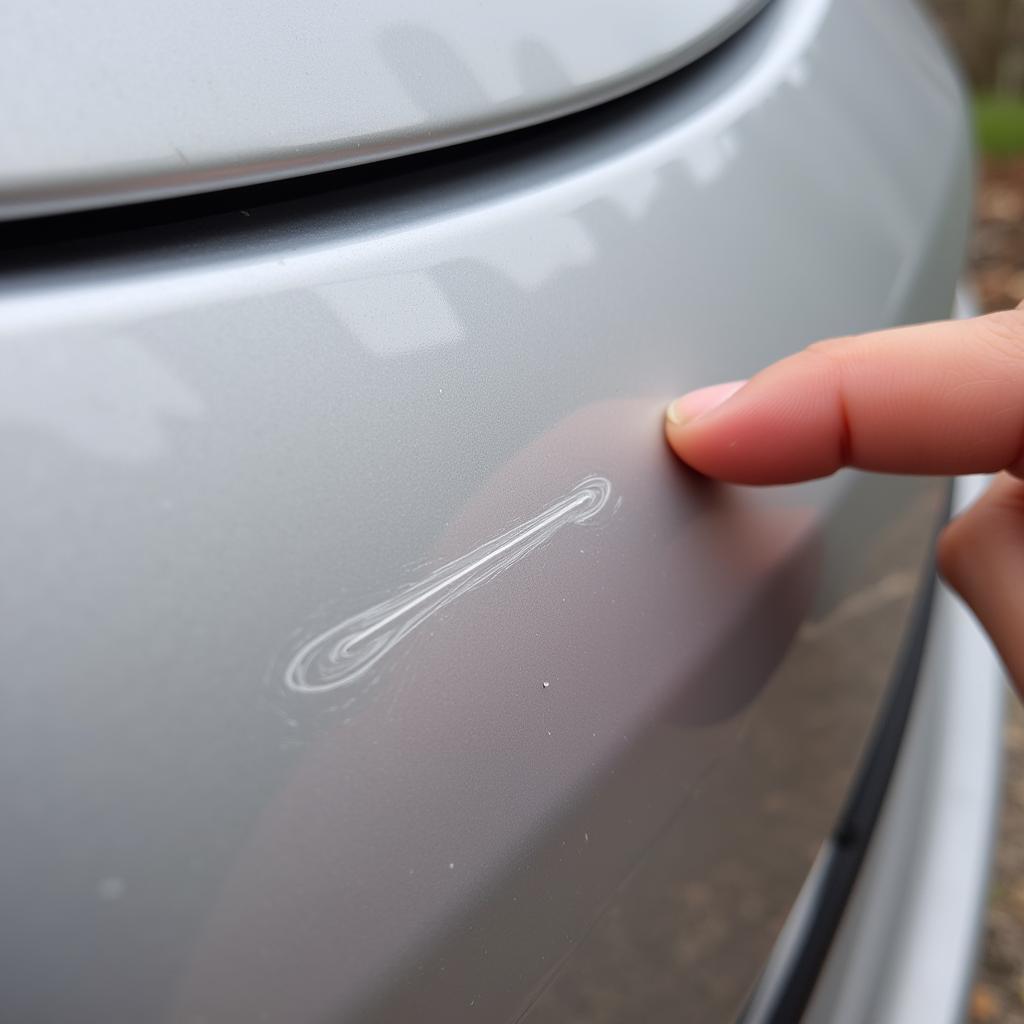Dealing with a small scratch on your car’s paint can be frustrating. Luckily, minor scratches often don’t require a costly trip to a professional. This guide will walk you through how to repair a small scratch on car paint yourself, saving you both time and money.
Learning how to repair a small scratch on car paint involves assessing the damage, choosing the right materials, and carefully applying the fix. We’ll cover everything from identifying the scratch type to achieving a professional-looking finish. You’ll be able to confidently tackle those minor blemishes and keep your car looking its best. how to repair small scratches on car paint provides a quick overview if you’re short on time.
Identifying the Scratch
Before you begin the repair process, it’s crucial to determine the depth of the scratch. A small scratch that only affects the clear coat is relatively easy to fix. However, deeper scratches that penetrate the base coat or primer require more extensive repair. Wash the affected area thoroughly with car wash soap and water to remove any dirt or debris. Once clean, run your fingernail across the scratch. If your nail catches, it indicates a deeper scratch.
Clear Coat Scratches: A Simple Fix
Clear coat scratches are the easiest to repair. These superficial scratches often appear as light lines or swirls on the paint surface.
Base Coat Scratches: Requires More Attention
If the scratch penetrates the base coat, the repair process involves a bit more work and requires touch-up paint.
Primer Scratches: Professional Help Might Be Needed
Scratches that reach the primer often require professional repair to prevent rust and ensure a proper finish.
Gathering Your Supplies
The materials you’ll need depend on the depth of the scratch. For clear coat scratches, you’ll need rubbing compound and polishing compound. Deeper scratches require touch-up paint, primer (if the primer is exposed), clear coat, and sandpaper of varying grits. Microfiber cloths and masking tape are essential for any repair. small car paint scratch repair details the supplies needed for different scratch types.
Repairing a Clear Coat Scratch
Wash the area and dry it thoroughly. Apply a small amount of rubbing compound to a microfiber cloth. Rub the compound onto the scratch using gentle, circular motions. Continue rubbing until the scratch disappears. Follow up with polishing compound to restore the shine.
How do I know if I’ve rubbed enough?
The scratch should disappear completely, leaving a smooth and even surface.
What if the scratch is still visible after rubbing compound?
Try repeating the process or using a slightly more abrasive rubbing compound.
Repairing a Base Coat Scratch
Clean the area and dry thoroughly. If there are any rough edges around the scratch, lightly sand them with fine-grit sandpaper. Apply a thin layer of primer (if necessary) and let it dry. Then, apply several thin coats of touch-up paint, allowing each coat to dry before applying the next. repair small scratches in car paint provides a detailed guide on this process. Finally, apply a layer of clear coat to protect the repair.
Can I use any kind of touch-up paint?
No, use touch-up paint that matches your car’s paint code.
When to Seek Professional Help
While many small scratches can be repaired at home, some situations require professional attention. Deep scratches, large areas of damage, or scratches that have penetrated to the metal should be handled by a qualified auto body repair shop. They have the expertise and tools to ensure a proper and lasting repair. classic car small paint scratch repair offers specific advice for classic car owners.
Conclusion
Repairing a small scratch on your car paint can be a straightforward DIY project if you follow the correct steps. By identifying the scratch type and using the right materials, you can save money and keep your car looking its best. Remember to always assess the damage carefully and seek professional help if needed. Knowing how to repair a small scratch on car paint empowers you to address minor blemishes effectively.
FAQ
- How long does it take for touch-up paint to dry? Drying times vary depending on the product and environmental conditions, but it typically takes a few hours to fully dry.
- Can I use nail polish to repair a car scratch? While it might be a temporary fix, nail polish isn’t designed for automotive paint and can damage the clear coat.
- What is the best way to prevent car scratches? Regular washing and waxing, parking in covered areas, and avoiding tight parking spaces can help prevent scratches.
- Where can I find my car’s paint code? The paint code is usually located on a sticker inside the driver’s side doorjamb or in the owner’s manual.
- How can I remove swirl marks from my car’s paint? Using a polishing compound and a microfiber cloth can help remove swirl marks.
- Can I repair a scratch on a leased car myself? It’s best to consult your leasing agreement before attempting any repairs.
- Is it necessary to apply clear coat after repairing a base coat scratch? Yes, applying clear coat protects the repair and ensures a uniform finish.
Common Scratch Repair Scenarios
- Key scratches: These are often deep and require professional repair.
- Rock chips: Small chips can be repaired using touch-up paint.
- Scratches from tree branches: Superficial scratches can be buffed out with rubbing compound.
For further information, you can visit our other helpful articles such as classic car small paint scratch repair use single stage paint.
Need help with car diagnostics or repairs? Contact our 24/7 support team via WhatsApp: +1(641)206-8880 or Email: [email protected]. We’re here to help!

